Riq Basic Lesson
The tambourin of the Arabic world. It has 10 pairs of jingles in 2 rows around the frame. The skin is usually fish-skin, but also different kinds of animal skins and synthetic skin are used. It is played with a very elaborated technique where the fingers hit the skin and also the jingles.
watch the beginning chapter from instructional DVD “Worldpercussion 2 – Riq and Darbuka”
Position
Holding the Riq is a little tricky in the beginning. You open your left hand and place the instrument between your thumb and index finger. The thumb is placed on the back of one jingle pair and the index finger holds the drum at the edge of the skin. It is not a question of force but of balance. When you play, tilt the drum a little away from yourself to keep the jingles as quiet as possible.

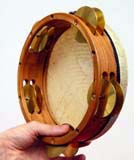
Doum
For the bass sound you use your right index finger and hit the skin at the side so that 2/3 of the finger hit the skin.

Tak
This stroke is done with the ring finger. You hit the skin at the very edge of the drumhead.

Pa
This is what we know from other drums as slap. You hit the skin with all four fingertips in the midle of the drum.
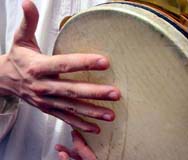
the jingles
The jingles are mostly played with the left and right ringfingers.
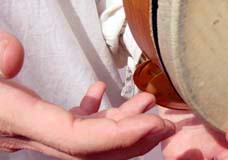
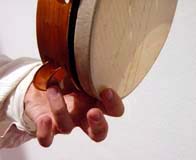
It is also possible to produce a lot of different sounds by using different techniques of shaking and you can play different rolls using more fingers, most commonly the right index-, middle- and ringfinger.
The Riq – soft position
This position is used to play more softly than in the standard position. For holding the instrument you form a “U” with both hands and place the instruments between the thumbs and index fingers of both hands without grapping.
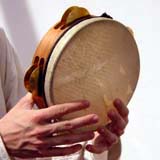
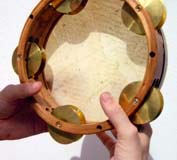
Doum
The bass stroke is done with the right ringfinger. The movement comes mostly from the wrist and the finger bounces off immediately.
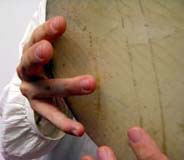
Tak
This one is a little tricky. In this position “Tak” is not an open sound, but closed. To make the sound closed, you put both index fingers on the skin and press just a little bit while your ring fingers play on the edge of the skin. The difficult part is to close the “Tak” sounds, but lift your index fingers for the bass sound.


Below you see the middle-eastern rhythm Malfuf. Its rhythmical subdivision is 3-3-2. You find this pattern in different music cultures all over the world. For the start play just the accents:

![]()
There are different ways to use the jingles and fill up the rhythm. For example you can add a note before every tak.

![]()
or play the jingles continously between the accents:

![]()
When you lift your left thumb from the jingle while playing, you get another jingle sound. Now two pairs of jingles sound at the same time, sounding more open and ringing. In the second example the last accent is substituted by a stroke on the jingles, so that the last four notes you play are open jingles.

![]()

![]()
You can put the open jingle sound to many different places inside the rhythm. Just experiment.
If you add a second pattern, you have another middle-eastern rhythm called Chiftetelli.:

![]()
Now use the jingles to fill it up :

![]()

![]()
Apart from playing the jingles directly with the fingers, you can shake the instrument back and forth to get another sound. You tilt the instrument backwards after a right hand stroke and forward on the next 16th. There are different places where you can put this movement inside the Malfuf rhythm. You can hit the drum again with your right hand together with the forward motion like in the next example, or wait until the next 16th like in the two following ones.

![]()

![]()

![]()
The next pattern is a combination of the last three:

![]()
The same technique now applied to the chiftetelli rhythm:

![]()

![]()
Now let´s have a look at the soft position. The tricky part are the index fingers. You have to press them on the skin for the taks, but lift them to get the open bass sound. First some exercises to get a feel for the movements:




The next 2/4 rhythm is called Karatchi:

![]()

And now back to the Chiftetelli. In the soft position you can play it like this (in the second example two pickup notes are added):

![]()

![]()
These are some examples to play rhythms in different ways. Of course there are many more. Try the different jingle sounds. Also you can substitute the “taks” with slaps or with bass sounds. The possibilities are endless.
© David Kuckhermann 2006


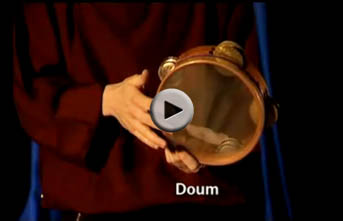


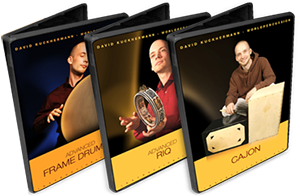
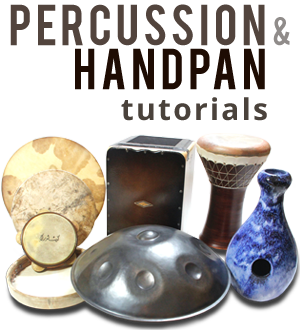
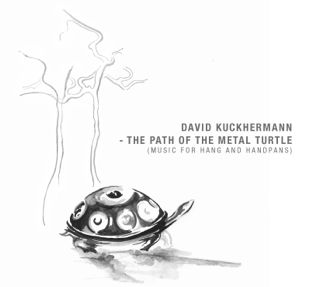
Very informative lesson, great notion. I find the puctures to be extremely useful, especially in holding of the riq. The riq possibilitys & technique are awesome & great on other drums to (I.e tamburello)
Tres fort, malheuresement personne à Paris pour se perfectionner plus en profondeur sur le riq.
merci david bravoo